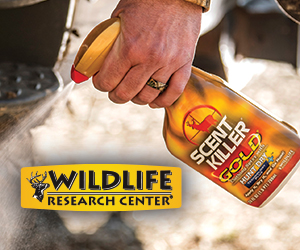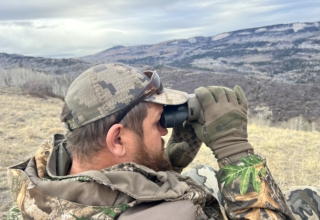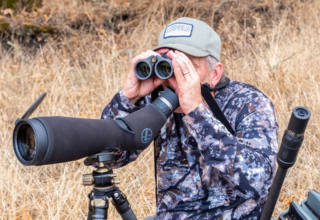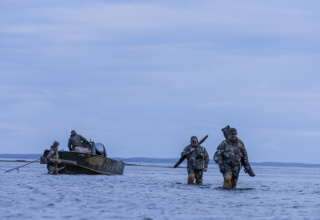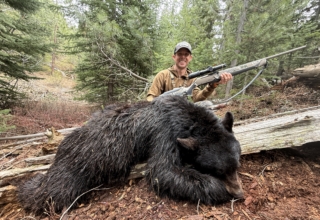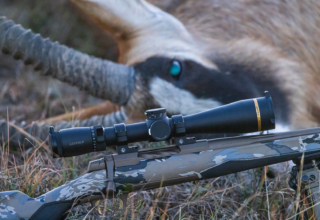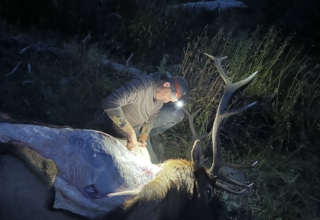Author, Scott Haugen, gave up his beloved Columbia black-tailed deer tag this season for a crack at a prized Columbia whitetail, and got a case of whitetail fever.
by Scott Haugen
When the big Columbia whitetail buck slipped through a livestock fence and onto another property, my stomach churned. I feared I’d never see it again.
Three months of scouting, countless hours running trail cameras and baits, and my dream buck was gone. Swallowed by thick cover, the buck knew the game. With one day left in the hunt, I had a decision to make.
Meet The Columbia Whitetail
Ninety minutes from my home is the only huntable population of the Columbia white-tailed deer. Back in the 1950s and early ’60s, my family regularly hunted these now-prized gems. Back then, the deer were considered a nuisance to landowners and ranchers. Hunters could shoot Columbia white-tailed deer during a general season with a Western Oregon over-the-counter deer tag.
Then the season closed for almost 40 years due to population declines.
In 2005, the Columbia whitetail deer season opened once again. Landowner and limited draw tags were highly sought after. Some landowners and outfitters were fetching $10,000 per tag. My wife drew a tag the first year it reopened. She held out for a big buck, one we never found. She went home without firing a shot.
The following year, I got a Columbia whitetail tag and shot a mature buck, not a giant. Weighing no more than 120 pounds, it was one of the best-eating deer we’d ever consumed.
The Whitetail Bug
This season, an opportunity came my way, one I never thought would again. I secured a landowner tag to hunt Columbia whitetails. In late July, I joined longtime friend and noted guide, Jody Smith of Jody Smith Guide Service. Smith secured two whitetail tags for this property. I had one of them.
I spend more time hunting, scouting, and running trail cameras with Smith than anyone. We cover a lot of ground over the course of a year in search of Roosevelt elk, Columbia black-tailed deer, bear, cougar, predators, and turkeys. It’s a year-round passion. But this was our first Columbia whitetail hunt together.
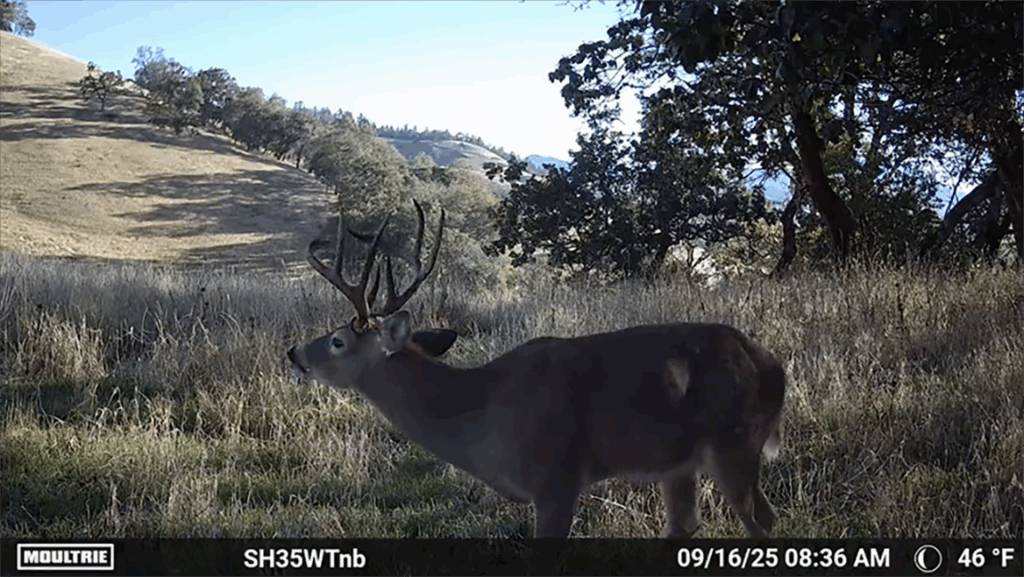
“Once you see how these deer pattern, you’ll be surprised how addicting it gets,” Smith shared on our first run to set trail cameras. “And when you find a big buck, you’ll become obsessed with it,” he smiled.
Smith has been guiding hunters to prized Columbia whitetails for nearly a decade. He’s been guiding elk and blacktail hunts for over 30 years.
Smith and I set up two Moultrie Mobile deer feeders, and I controlled feeding times on the Moultrie Mobile app on my cell phone. We also hung multiple Moultrie Feed Bins and tossed out some Mossy Oak deer blocks. That afternoon, every single feeder and bait were hit. Never having run deer feeders, the instant action excited me.
I’ve hunted whitetails in multiple Western states. They’ve all been spot-and-stalk hunts. No feed. No patterning of deer. The Columbia whitetail was different. When a big buck in velvet showed up, its main beams sweeping wide and far forward, I became consumed with patterning it.
A few days after the big buck appeared, Smith and I went to scout and hang more cameras. That’s when we laid eyes on it for the first time. It was an exceptional buck, especially in velvet. That was the buck I wanted.
The Emotional Roller Coaster
The buck appeared on two trail cameras consistently, often in daylight. “This is going to be easy,” I thought. Then, 10 days before the season opener, the buck showed up on the trail camera. It had broken off the left side of its rack at the base of the brow tine. I was devastated. How this could happen to a healthy buck with such massive bases was beyond me. The probability of being hit by a car seemed most sensible. These deer live almost exclusively on private land and constantly cross roads.
The next day, Smith and I were back in the whitetail hills. We tediously surveyed the 2,300 acres of rolling, yellow-grass hills studded with oak trees. Bedded in thick patches of poison oak and blackberries, and beneath the shade of oak trees, we spotted many whitetails, but none as big as the target buck.
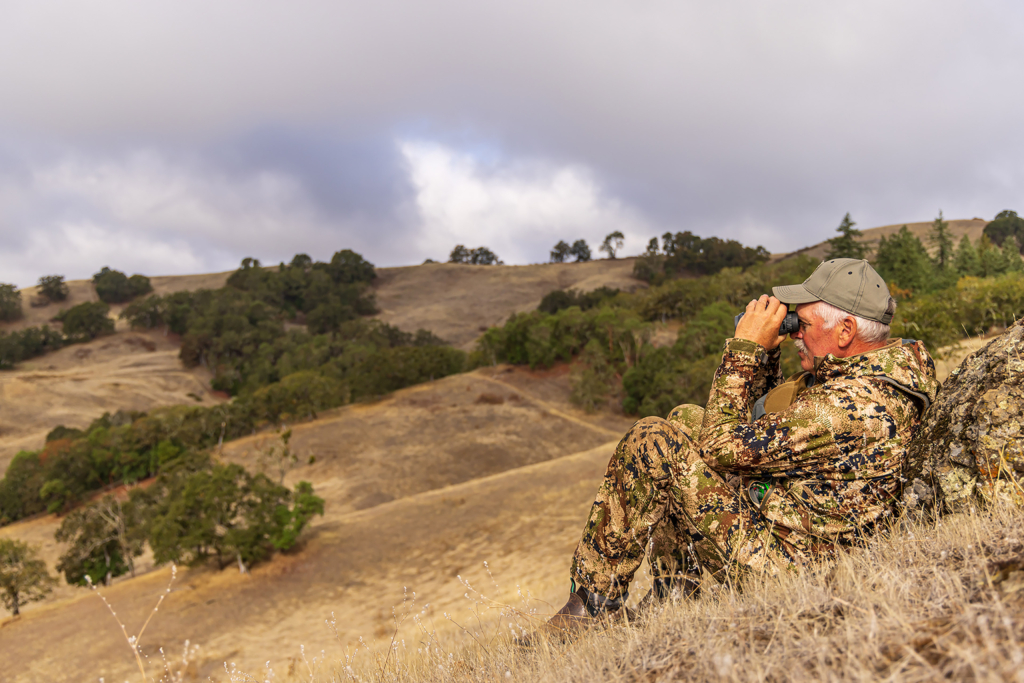
Then, when driving the ATV down a steep hillside, a buck jumped up less than 20 yards from us. The buck was deep in a blackberry thicket.
“These things hold like quail,” Smith spouted as he slowed the ATV to a stop.
The buck paused on the edge of a patch of poison oak. Its tall, heavy rack and impressive eye guards took my breath away. Its tines weren’t as long as the broken antlered buck’s, but it was heavy and old.
“That thing has a freaky right side, look at that kicker and extra tines,” Smith whispered. We had a new target buck, dubbed “The Freak.”
After moving the trail cameras and food, The Freak started hitting them that afternoon. Two days before the season, Smith and I freshened baits and again laid eyes on our target buck. This time, the buck was low on a hillside, standing near a fence on the property line.
“We’ve gotta get that buck up on the hill, away from the fence,” Smith commented.
On the other side of the fence was dense cover and a series of ponds. Water is life in this part of western Oregon. Summer temperatures routinely surpassed the century mark, and it was a dry year. Shade and water are essential to the survival of deer in this area.
On opening morning, I was in position. Smith stayed on the high ground to glass. As fog lifted from the valley below, I could clearly see The Freak’s domain. I glassed three bucks, two of which were shooters, but I kept my finger off the trigger. Then, 90 minutes into the morning, the familiar, white, heavy rack flowed over a dark line of poison oak. The Freak was headed to a block to feed. All I had to do was wait.
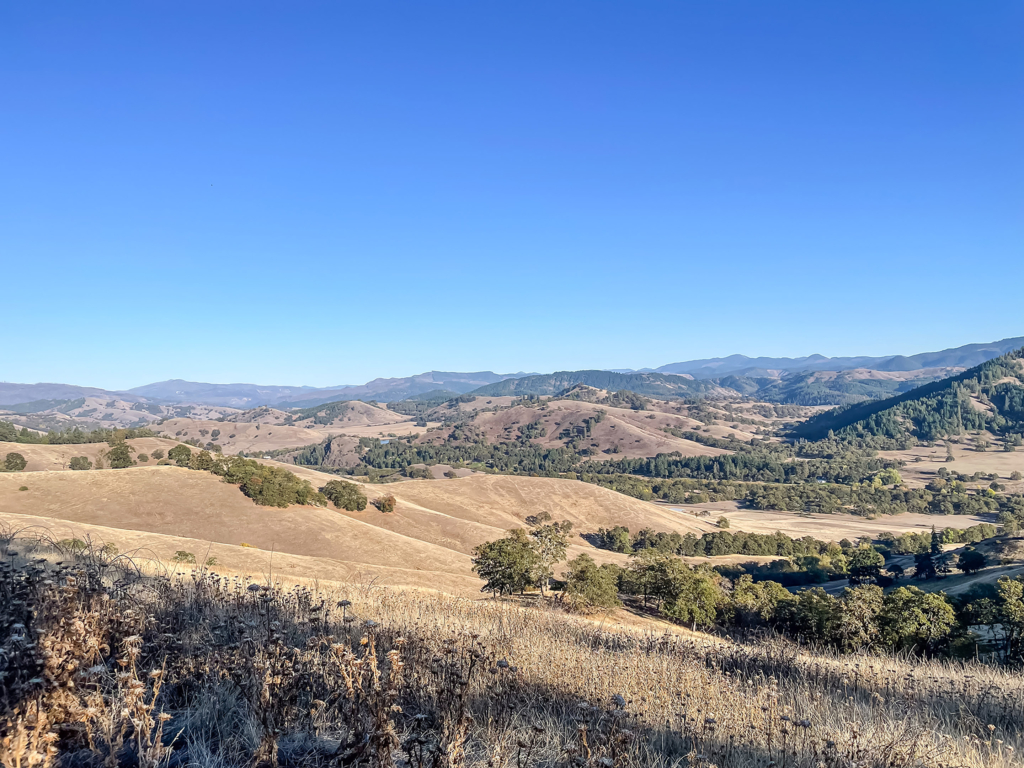
Set solid in the tripod shooting sticks, I could see the buck’s head. At over 300 yards, there was no shot. The bait was inside 200 yards. The buck was headed straight for it until another buck appeared. When The Freak saw the tall three-point, he turned and strutted right at it. The rigid walk and upright neck screamed pre-rut. When the two bucks locked antlers and pushed one another down the hillside, out of sight, I made a move.
With the new buck challenging the boss, I figured they’d be sparring long enough to allow me to hustle into position for a shot. With The Freak’s attention turned to another buck, I also thought it would forego food. I was wrong.
In less than five minutes, I was where I wanted to be, overlooking the knoll where the sparring bucks had disappeared. But for the life of me, I couldn’t find them. Edging forward to see over the rolling hillside, the wind was perfect, moving left to right. The bucks had to be below me, but where?
A few minutes later, brush to the right of me erupted. The Freak’s rack glowed in the dull, morning light as it sped away. At 130 yards it stopped. The shot would have been easy, but a thick stand of poison oak totally screened the buck. I waited. One step in either direction, and the buck would be clear for a shot.
However, rather than step, the buck buckled down and emerged on a full sprint. There was no shot as it sped through thickets of brush. Just under 300 yards, the buck stopped and looked back. I could have shot, but didn’t. It was next to a property line, and I was shooting a .243 Win. Confident the 100-grain bullet would be lethal, I needed a high shoulder shot to drop the buck, not a double lung hit that would see the buck likely jumping the fence and expiring on the other side. In hindsight, I should have shot. It was a costly mistake.
However, it was day one. Surely I’d see the buck again during this five-day hunt, I wasn’t too worried.
The Consolation Buck
The following morning, we were back, glassing the hillside and thicket where The Freak lived, but the wind was wrong.
“Let’s back out and give it a couple of days to calm down,” suggested Smith. “Let’s go to the other side of the property, new bucks always show up once the season starts.” Smith knew I wanted this buck. In the first two days, we’d laid eyes on 32 whitetail bucks, nearly 1/3 of which would have qualified for the record books. But The Freak was in a class by itself.
On day four, Smith and I were once again overlooking the Freak’s domain. The brute was nowhere to be
seen. With time running out, we made a push. We saw The Freak one last time. But after the push, he was gone forever, swallowed by the sanctuary of another property.
With one day left in the hunt, I had a decision to make. Two days prior, Smith and I glassed a bedded buck with split eye guards. It was one we’d caught multiple times on trail camera over several weeks at one of the Moultrie feeders. But the buck was always coming in at night. We watched it for nearly 10 minutes.
“If we have to, we’ll come back and try to find this buck,” said Smith. “Looks like this is where it’s bedding for the day.”
I’m not a trophy hunter, but I thrive on trying to outwit mature bucks. It’s more the process of what it takes to outsmart wise, old bucks, wherein my addiction lies, rather than total inches of antlers. In fact, I’ve never entered an animal into a record book.
I could have easily filled my tag on opening morning, but oh, what I would have missed. By the time I filled my tag, Smith and I laid eyes on 42 bucks. Many were mature bucks. We hunted daylight to dark, even glassing in the midday heat when the shifting sun forced bucks to change bedding locations to avoid 80-degree-plus temperatures. To become better hunters, we must spend time afield. I was in no hurry for this hunt to end.
On the last morning, Smith and I sat on the edge of a creek bottom well before daylight. As dawn broke, Columbia whitetails began filtering into wooded, brushy draws. Five bucks moved by, three of which were hard not to pull the trigger on. Then our consolation buck emerged.
I was rock solid in the shooting sticks, the glowing FireDot of the Leupold scope right where I wanted it. At 154 yards, the shot was simple.
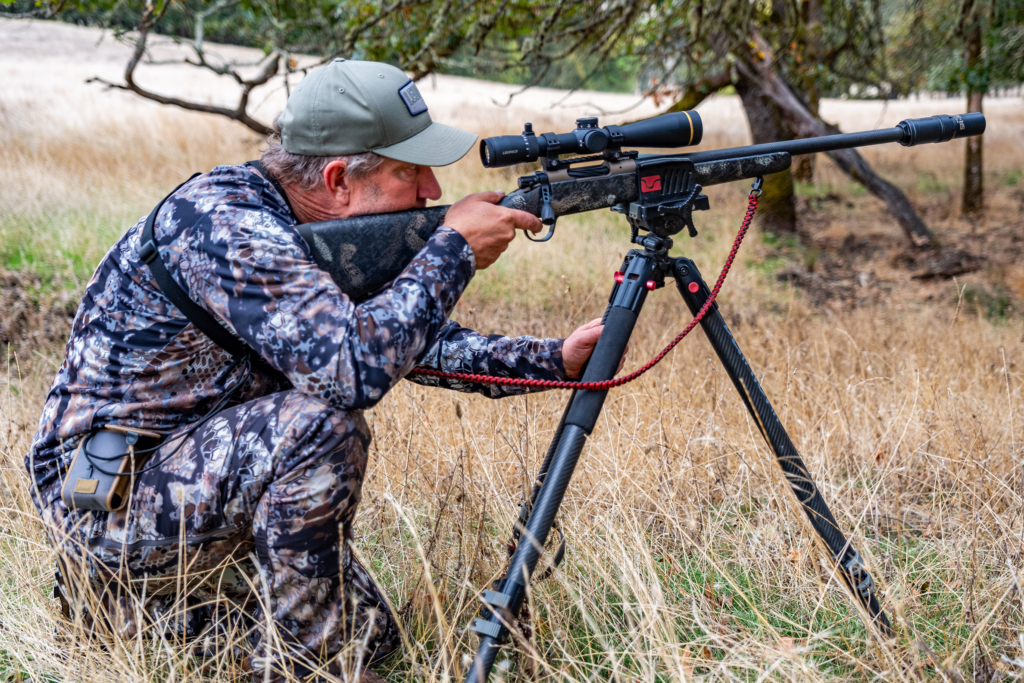
Feelings of ambivalence consumed me. I was elated to take a nice buck with one of my best friends by my side. I was so happy that the hundreds of miles driven and countless hours spent scouting resulted in some great eating meat. But I felt defeated, failing to close the deal on The Freak.

The whitetail bug had bitten me, something I’d never experienced in 49 years of deer hunting. The long weeks of scouting and a brief season were full of ups and downs. At times, I loved it. At times, I hated it. But what I learned on that three-month journey took my appreciation for and understanding of Columbia whitetails to another level.

I’ll likely never have another chance to hunt these grand little deer during my lifetime. But the sheer joy and challenges these whitetails provided will never be forgotten. For the first time, the pursuit of whitetails consumed me. I’ll miss that.
The Gear
On this hunt, I was shooting a Christensen Arms Ridgeline FFT chambered in .243 with a 20-inch barrel. I’ve shot several animals with their rifles over the years, and love the smooth, easy operation of this gun. It’s a lightweight tack driver that’s fun to shoot and punches dime-size groups at 100 yards, off sticks.
Nosler’s Whitetail Country 100-grain solid base was the bullet of choice. I intentionally shot my buck high on the shoulder. The bullet passed through the near shoulder blade, exited the other one, and dropped the buck on the spot. The meat damage and bloodshot were minimal, less than a quarter pound of meat loss, total.
An illuminated reticle is something I wish all hunters could shoot, or at least experience on a hunt. It’s a game-changer for quick target acquisition and accurate shot placement, especially in low-light conditions and while hunting amid cover. The rifle was topped with Leupold’s Gen 2 VX-5HD in a 3-15×44. The duplex FireDot is simple and fast to control, and the clarity of the scope, impressive.
The rifle was tipped with Nosler’s SR-30KH suppressor. I’ve been an advocate of suppressors since first using them in Africa over 30 years ago. This one rounded out a compact build while still delivering noticeable noise reduction and reduced recoil, even on a small bore.
The scope was fitted with Leupold’s Custom Dial System (CDS), another technological benefit that increases shooter accuracy. Though I didn’t need it on this deer, I practiced with the CDS out to 300 yards and it was spot-on.
Not only is this setup great for deer, but I’d love to make it a go-to coyote gun. It’d be perfect in many of the places I hunt deer and predators.

